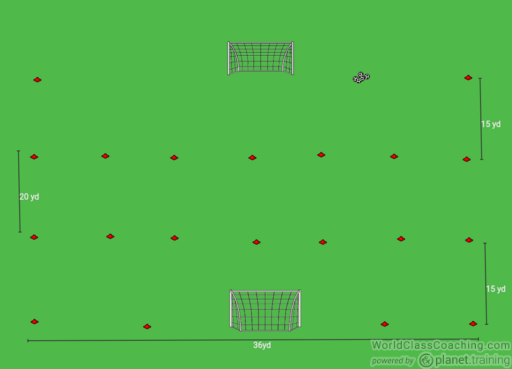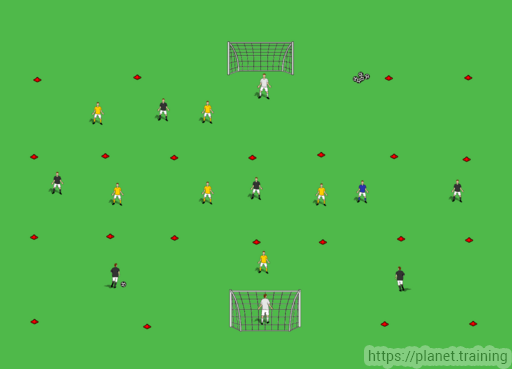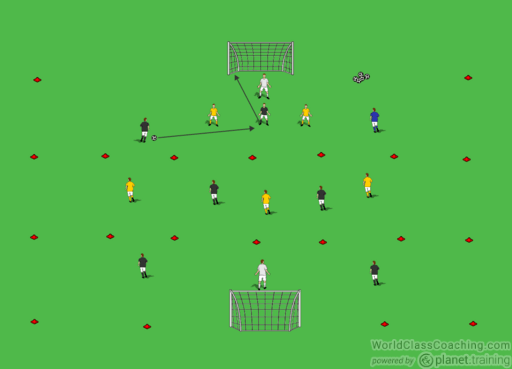By Anthony Hazelwood
The following activity has two teams of players playing a 7 vs. 7 + N. The idea is to have players understand proper shape and support throughout functional lines to maintain possession and to penetrate. The fitness portion of this activity is training the anaerobic capacity with muscle tension action in a small sided activity. Although numbers are higher in this activity, the players are still split into zones and they will be playing in small sided numbers (i.e. 4 vs. 3 in middle zone) therefore keeping muscle tension and eccentric actions.
When preparing the practice, if needed, concentration and difficulty levels may be increased by having players execute something extra unique by setting more restrictions. Every activity may be modified, and it is up to the coach to be creative. However, it is important to respect the parameters of the exercise time, the rest, the types of actions used and the weekly periodization of the activity.
Additionally, it is beneficial to train a soccer team and its players with all elements of the game is present in the session. By doing so, it will promote soccer specific adaptations to the player’s body, mind, and emotional triad. Ultimately, these adjustments will enhance their real-time game performances on a physical, emotional, conscious, and subconscious mental level.
Area Size: Activity Grid: 50 yds. L x 35 yds. W.
Total Activity Time: 20 Minutes.
Sets: 1 set.
Activity Repetitions: 4 repetitions.
Time of Activity Repetition: 4 minutes.
Recovery Interval Time: 1 minutes.
Intensity: High.
Objectives:
• Tactical: Train team proper shape and supporting play, with the intent to penetrate to go to goal.
• Fitness: Anaerobic Capacity – Muscle Tension.
• Technique: Proper fitness and off/on the ball execution/techniques.
• Mental-Emotional: Players fully engaged and concentration is high.
• Concentration Level: High.
Setup:

• The coach will instruct the team in Black.
• Activity Grid: 50 yds. L x 36 W.
• Three zones are marked with the grid.
• The length of zones is: 15 yds. – 20 yd. – 15yd.
• Black team: Initially, one GK and two CB’s players are put in the defending third zone, three midfield players in the middle third and one attacker in the final third zone.
• There will be a neutral player in the midfield third.

• Players are restricted to these zones until restrictions are broken.
• The ball always starts from the back.
• To transfer the ball into the midfield zone, players in the defending third must complete four passes.
• Once completed, the CB’s or GK may look to play a pass into the second zone to midfielders or neutral player.
• Once the ball is in the midfield zone it is a 4 vs. 3.
• The CB’s and GK stay in their defending third zone and may be played during possession. However, passes played into CB’s does not break restrictions.
• The idea here is to have the back two CB’s and GK become always available with proper support, shape, and distances just in case the ball needs to be played backward.
• Defenders still stay in their zones if this is the case.
• To advance into the attacking third zone, the black team in the middle third must complete 3 passes.

• Once completed, two players from the midfield third may move into the attacking third into a 3 vs. 2 scenarios. Free play to score is amplified.
• If the yellow team wins the ball during play, they have 8 seconds to shoot score on goal. If not, ball is replayed from the back with team in black.
• Rotate team roles if needed.
• There will be three extra players idle on sideline during a repetition. Make sure to rotate and have them do extra work on sideline.
By Anthony Hazelwood
Current Seattle Sounders Academy Performance Coach with previous European academy coaching experience as an assistant fitness and strength/conditioning soccer coach with Levante U.D. (2013-2014) and Getafe SAD CF (2015-2016) in Valencia and Madrid, Spain respectively. A USSF “A” licensed coach with a BSc in Physical Education and an MSc in Sports Training and Nutrition.


